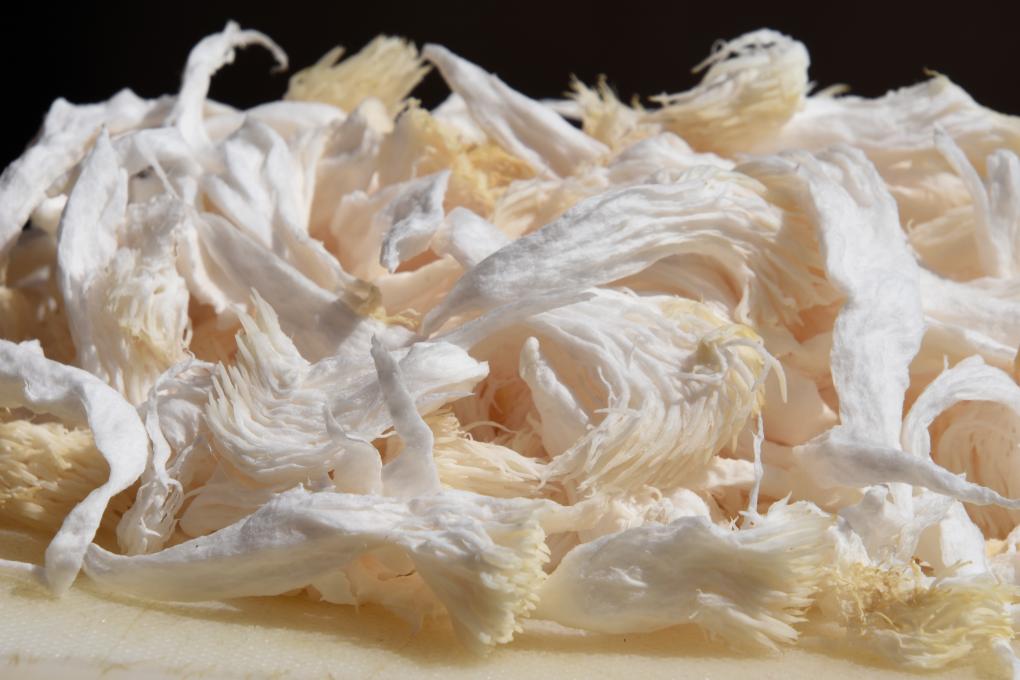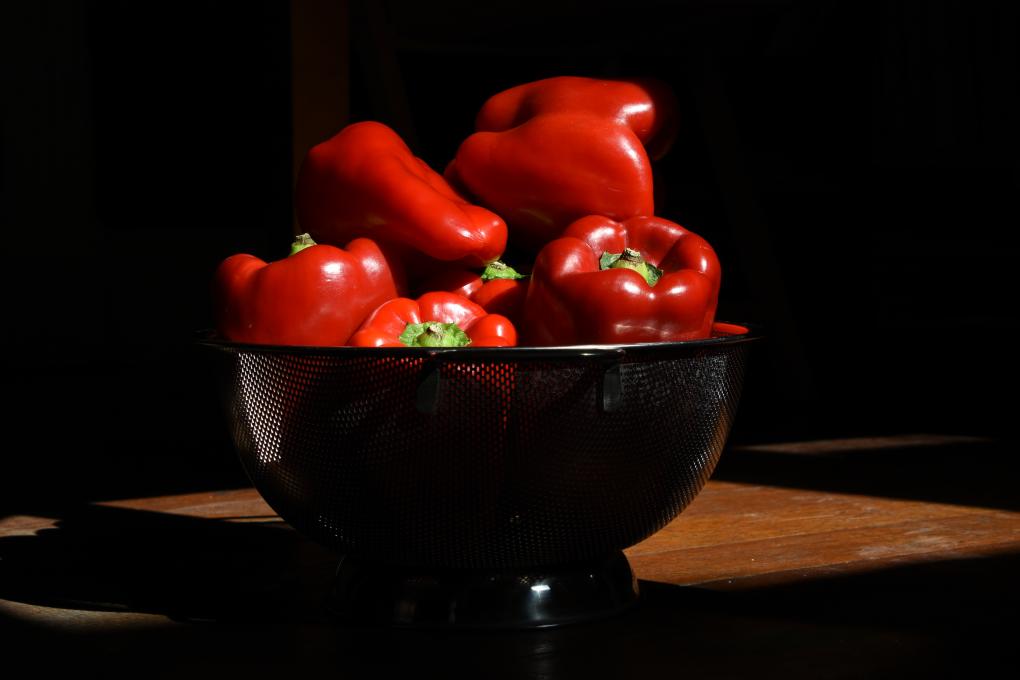The Cornell Lab Bird Academy › Discussion Groups › Nature Journaling and Field Sketching › Jump Right in!
-
I definitely struggled with drawing this photo. I am not great at drawing period, and with my kids around I really struggled to pit in the time I wanted to. However, my drawing was better than I it would be, so I am proud of myself in that sense. I think something I really noticed was the wing patterns, or any patterns in general are a huge benefit when you are drawing.
-
I loved trying to draw the warbler. I like using a photo as a reference. But I am most used to color pencils and was trying to use watercolor pencils for this one, since I thought maybe that's what would be used in the field. I noticed that the bird wasn't really looking sideways, he is somewhat looking toward us and I couldn't capture that. I noticed the black and yellow alternations in his wing feathers and that the steaks on his chest have some redness to them and are uneven.
 .
. -
I have a bit of a mental block about sketching, so this course will help me with that. I'm think I'm most interested in sketching plants, so it's great that the first project was NOT plants, but something that is likely harder, i.e. this bird. I do love bird watching! This was fun.

-
First I tried watercolor but found it difficult to get fine detail. So I then drew with graphite. It will be interesting to compare before course/ after course drawings!


-
LOVE the watercolor!
-
-
Drawing from a photo makes it easy to check proportions, but I still didn't get her all on the page. Missed off half her tail. Noticed that feathers tend to follow the shape of the body and that there are fare more tones in the bill than I thought. Starting doors make you look, especially when the drawing doesn't look right, and you try to figure out why.
-

-
 Forgot to insert my image.
Forgot to insert my image. -
I enjoyed the opportunity to truly study the bird with depth, but I found it challenging to capture all that I wanted to in especially in terms of proportion and perspective. However, drawing enabled me to see all the variations in color and the exquisite detail of its feathers and the different sections of feathers that I may have overlooked if I was just looking at a photo. I could see how drawing what I see will make me a more keen observer.
-
 I'm glad the course has us dive in right away and get to drawing. I couldn't quite get the tilt of the bird's head but I like drawing from photos and focused hard on not being too precious with it. I don't think I would have noticed the difference in the wing feathers as much. I also never noticed how much black striping there is on the wings, despite having photographed Yellow Warblers several times before.
I'm glad the course has us dive in right away and get to drawing. I couldn't quite get the tilt of the bird's head but I like drawing from photos and focused hard on not being too precious with it. I don't think I would have noticed the difference in the wing feathers as much. I also never noticed how much black striping there is on the wings, despite having photographed Yellow Warblers several times before. -
1. I did like drawing the leaves first and the bird afterwards. It came easily, the body of the bird was challenging to get the right measures. In addition, I found my bird is smaller than yours. 2. I did not notice a piece of wood, when I made the photo bigger, i have noticed it. I believe it depends on the time and experience. I wanted to draw nice leaves, but they are not nice for me. I guess I do not have a technique yet, but it will come. I have added the information on the previous page about the day, time and weather conditions. I did not want to color it because I am too curious to see another video tonight.

-
Apprehensive to start but then found it absorbing and enjoyable. What was easy was that the image was static, fixed, and thus there was no pressure of time or memory. The difficulty comes with selecting what is important to include or emphasize and what can be omitted ... I would omit detail in the surroundings of the bird, unless they were important data. I find it hard to get the proportions and shapes to come out right. I hope the course will help me with this skill. And the shading due to the play of light is a challenge, not so much in this exercise as the light is directly behind the observer and so the bird is fully illuminated, but often, that is not the case.

-
I always draw from a reference photo so there is no change there for me. I usually draw either flowers, butterflies, or comic book characters so the bird itself was something new. I gave myself an hour time limit because I know that in nature I won't have unlimited time with subject. So, leaving it as a sketch instead of a finished drawing was in itself a challenge for me. If I had taken a photo of the bird instead of taking the time to draw it I would not have noticed that the lower beak seems thicker than the upper half of the beak.

-
I enjoyed drawing the yellow warbler and was able to observe some of the finer details such as the red streaks on the breast and the veins on the leaves . Also , challenging to get the right angle of the branches and perspective of the bird in relationship .

-
The drawing forces you to really look at the details. I tried to get the correct scale. My drawing is probably too detailed for journalling, but I enjoyed doing it. The bird was challenging but you do see the beauty in the bird's feathers. It is interesting to see how the feet are gripping the branch.

-
Your drawing is so beautiful !
-
-
Rendering in pencil reminds me to be sure to note the colors of the features. A fun and challenging exercise! Anxious to try watercolor. Scrolling down I realized I will need to go back and include the branch and leaves like the others students.

-
Connie, I think you are okay. The directive said to sketch this bird with no directions and that you will be asked to sketch it again at the end of the course using the techniques and skills you have acquired during the course. I like your sketch. I think everyone is on varying levels of skills. I understand your thoughts as was doing some thinking myself as to whether I needed to even be in this class judging by the expertise of others. Then I thought it is okay....I am here to learn at my own rate. Just have fun and enjoy each step of the way. You really captured the glint in its eye.
-
-
Rendering in pencil reminds me to be sure to note the colors of the features. A fun and challenging exercise! Anxious to try watercolor. Scrolling down I realized I will need to go back and include the branch and leaves like the others students.

-

-
I have lots to learn! I am overwhelmed how to capture the variations in color and shading on the branch. I definitely needed the photo to understand the variation in shading of the wings and the chestnut brown striations on the belly. I am really excited to see what I can learn from this course. I have no experience with art instruction and look forward to adding this as a goal of a new activity to connect with my natural surroundings.
-
-
Drawing from a photo seems somewhat easy; you can look several times, find details (even if you don't include them!), etc. I wasn't perfect, but you can estimate distances (where the bird is on the branch, how far the leaves are) etc. It easy to miss things: the moss on and fungi (?) on the tree branch. Interestingly, I didn't draw those because I think I don't really know how! Haha! I haven't really done "nature journaling", but I have spent time with a not so spiffy camera, with a slow motor. It taught me to watch closely/look closely, but I still think I miss lots of details. This was a nice start. I look forward to what's coming.
-
Drawing ANYTHING seemed like a real challenge! I found the head region the most difficult, and did not worry much about getting the leaves done accurately. After the initial sketch, I tried adding color with my brand new pencils. I liked the result, then looked at the others posted here. I have a lot to learn!

-
I had the same feeling. "I have a lot to learn!" I love the soft look you achieved with the pencil strokes.
-
-
 I normally focus only on the bird itself, so adding the leaves was different and actually I think they are the best thing here.
I tend to try and capture the overall 'feel' rather than details so it's a bit naive in execution, maybe because I'm lazy or impatient.
I didn't quite get the bird right - in the photo he is angled toward the camera and in my picture he's more flat and 2D - capturing depth is something I want to be better at. I think this lacks personality because of that. Also the yellow really isn't right but I have a very limited palette of watercolours.
I did enjoy doing this though. And I love seeing other people's pictures.
I normally focus only on the bird itself, so adding the leaves was different and actually I think they are the best thing here.
I tend to try and capture the overall 'feel' rather than details so it's a bit naive in execution, maybe because I'm lazy or impatient.
I didn't quite get the bird right - in the photo he is angled toward the camera and in my picture he's more flat and 2D - capturing depth is something I want to be better at. I think this lacks personality because of that. Also the yellow really isn't right but I have a very limited palette of watercolours.
I did enjoy doing this though. And I love seeing other people's pictures. -
 I had to erase and redraw so many times and the proportions are still off. I find I have a hard time maintaining proportions, even when breaking images down into basic shapes.
I had to erase and redraw so many times and the proportions are still off. I find I have a hard time maintaining proportions, even when breaking images down into basic shapes.- It was still fun and I enjoyed concentrating on something like this!
- I noticed the belly/chest bumps were more pronounced and segmented than I originally thought.
-

-
 I tried to use the technique from one of the journalists in the introductory videos that said to look at the hidden circles within the bird to complete this sketch. The difficulty was that I saw way too many circles and then triangles, rectangles, trapezoids and so on! I got lost in the shapes and finally just went with my gut. What was most frustrating was that I kept jumping around the page and then settled on completing the bird last and spent more time with detail. I got overwhelmed with the level of detail that everything required and didn’t want to invest the time required so I budgeted accordingly. I just wanted to get it done! Overall, I am impressed with my first attempt and am looking forward to the skills I’ll learn along the way in this course. I love sketching but feel I am horrific at painting and watercolor. I’m really hoping to learn some helpful tips for that, but am terrified at the thought of attempting them at the same time.
I tried to use the technique from one of the journalists in the introductory videos that said to look at the hidden circles within the bird to complete this sketch. The difficulty was that I saw way too many circles and then triangles, rectangles, trapezoids and so on! I got lost in the shapes and finally just went with my gut. What was most frustrating was that I kept jumping around the page and then settled on completing the bird last and spent more time with detail. I got overwhelmed with the level of detail that everything required and didn’t want to invest the time required so I budgeted accordingly. I just wanted to get it done! Overall, I am impressed with my first attempt and am looking forward to the skills I’ll learn along the way in this course. I love sketching but feel I am horrific at painting and watercolor. I’m really hoping to learn some helpful tips for that, but am terrified at the thought of attempting them at the same time. -
I really like this. You got the shapes and proportions spot on and you captured the angle of the bird really well - so you really get that sense that he's looking at the camera like he is in the photo. Thanks for sharing!
-
-
I felt absorbed and interested. The shape of the bird was not so difficult but the subtle shading took a lot of re-doing and checking. The shading, in fact, I might not have registered consciously at all if I hadn't been asked to draw it.
-
Kathy kfoh57 here. Tried to add a comment with sketch, didn’t work. Was tricky getting started. Voice in my head said, you can’t do this, pursued anyway. Trying to keep it simple. Was a good lesson.
-
I am totally new as well! Each time I sketch, I go from hopeful, to discouraged, to enjoying the process exploration, discovery, and greater understanding of the subject. It's that last leap that is hardest, and I have to make a conscious choice to make it! I hope I can continue to do so. The wildflowers in my yard are extraordinary. I feel the pressure to sketch each variety (and there are so many!) before they are gone. Beauty can be so transient.
-
@Paula Paula. Why not stop and sketch your wildflowers while they are there. Wildflowers are nature and can add spark to your journal. You can apply your skills to the flowers. Anything you sketch is another step to sketching the bird you might want to sketch later. Your bird could be in a field of wildflowers or by a wildflower or two. The class is self paced and you can take as long as you want. I just read a Japanese proverb that said ,"Be not afraid of going slowly. Be afraid of standing still." I want it to last a long time and am pacing it out. I have sketched more things that are not for the class than I have for the class. It's Easter so many Easter sketches, a Carolina chickadee feeding its young on a tree branch, a lady sitting in a comfy chair, etc and yes, flowers, too. Just have fun with the class and back away when it is not fun or pleasure. Thanks for sharing your desire to sketch wildflowers and I hope you share a few with us.
-
@Shir @Shir - Thank you! I am doing exactly that! I takes me a LONG time to even draw one blossom, but that is not reason not to try capture what I can, now and at my current skill level. I will have another year before I have THIS particular opportunity again. (Though I have plenty of photos should I choose to go that route.) I am both a bird-nerd and a food nerd and now I want to draw all my ingredients, too! For now I photograph them so they don't spoil awaiting my attention. Everything in the world is so interesting. It's a good "problem" to have. I'll try to attach a few food photos to show why ingredients capture my eye! This morning: "quick snap a mushroom photo before the butter melts in the pan!!"


-
 .
. 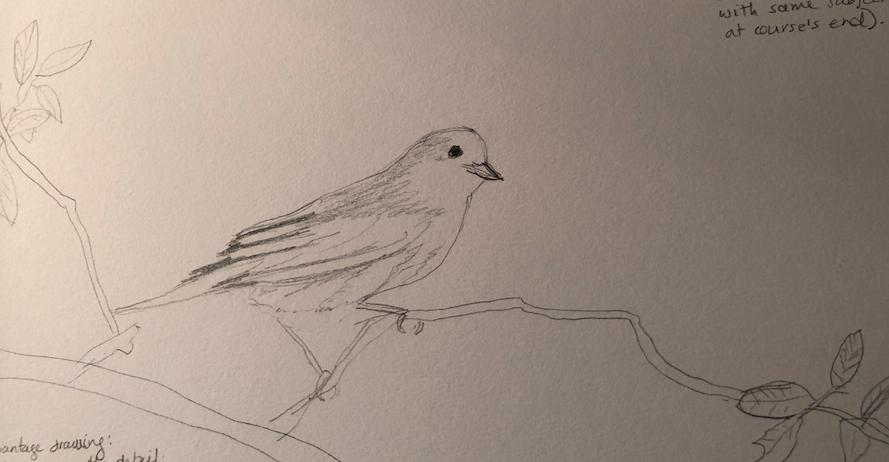
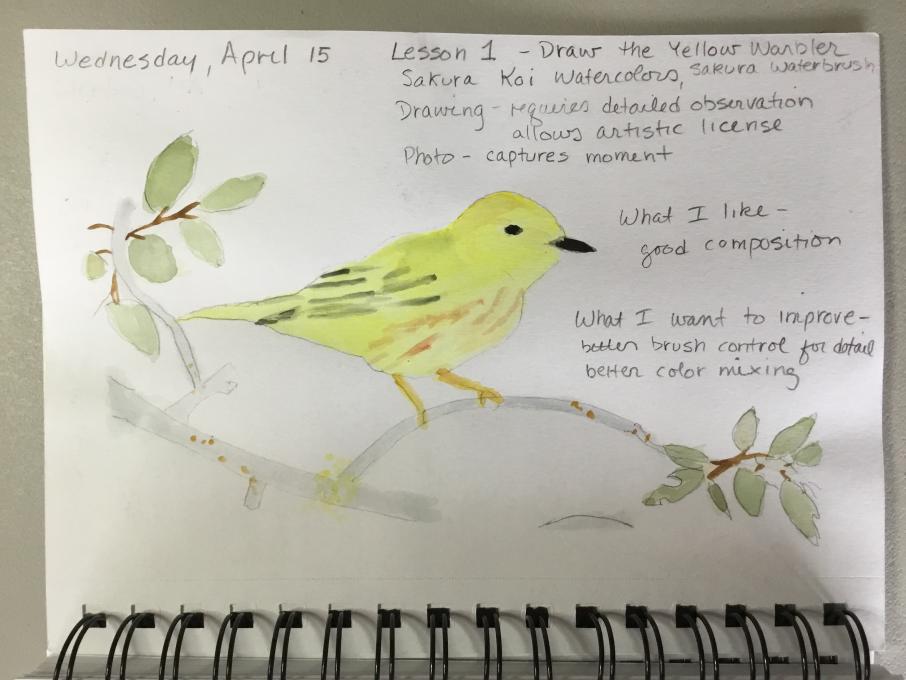


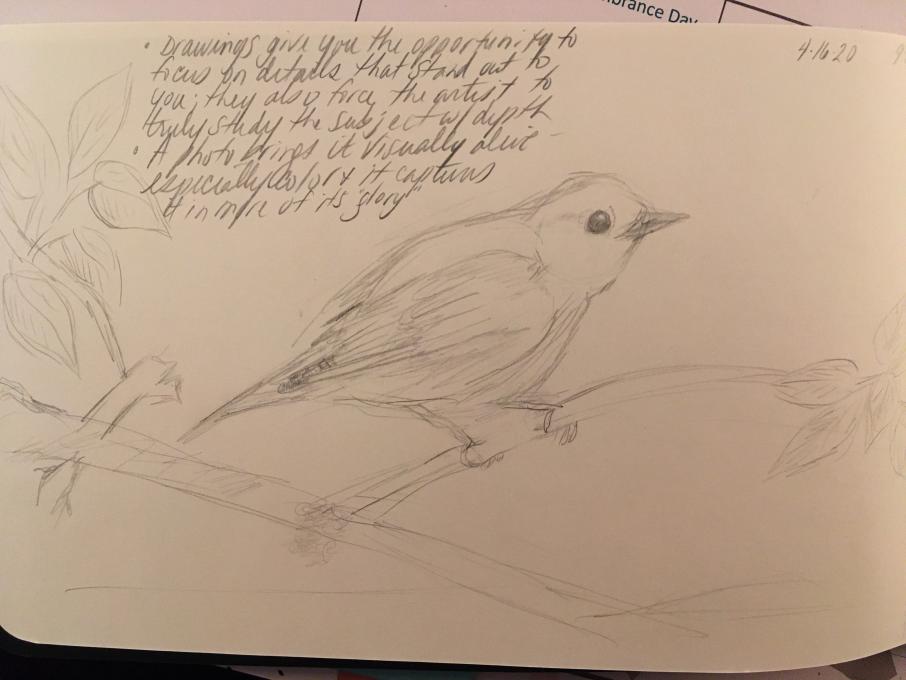 Forgot to insert my image.
Forgot to insert my image.  I'm glad the course has us dive in right away and get to drawing. I couldn't quite get the tilt of the bird's head but I like drawing from photos and focused hard on not being too precious with it. I don't think I would have noticed the difference in the wing feathers as much. I also never noticed how much black striping there is on the wings, despite having photographed Yellow Warblers several times before.
I'm glad the course has us dive in right away and get to drawing. I couldn't quite get the tilt of the bird's head but I like drawing from photos and focused hard on not being too precious with it. I don't think I would have noticed the difference in the wing feathers as much. I also never noticed how much black striping there is on the wings, despite having photographed Yellow Warblers several times before. 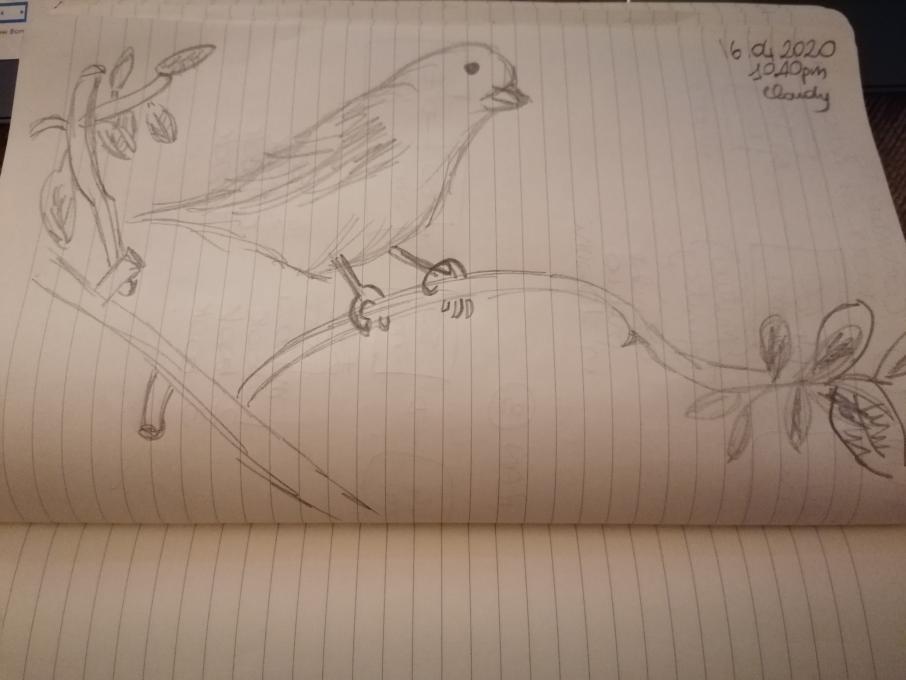
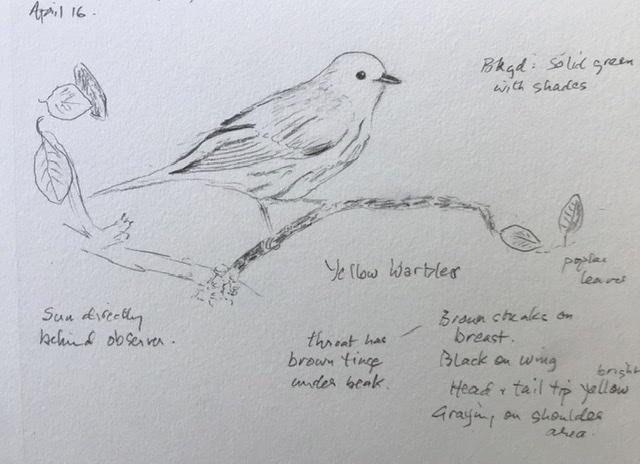
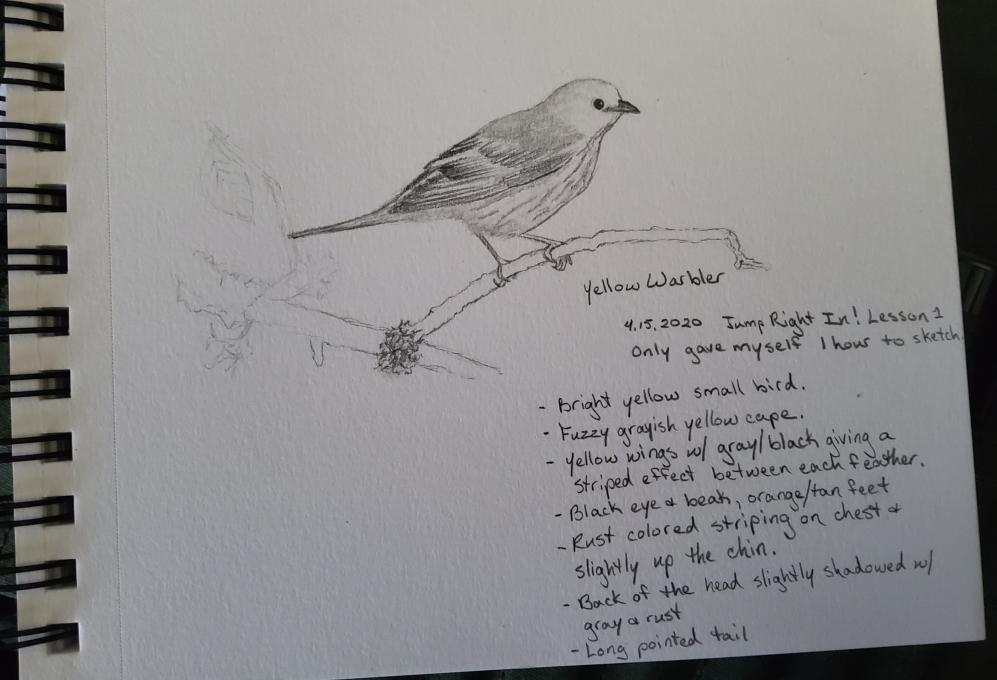
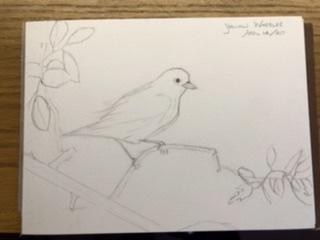
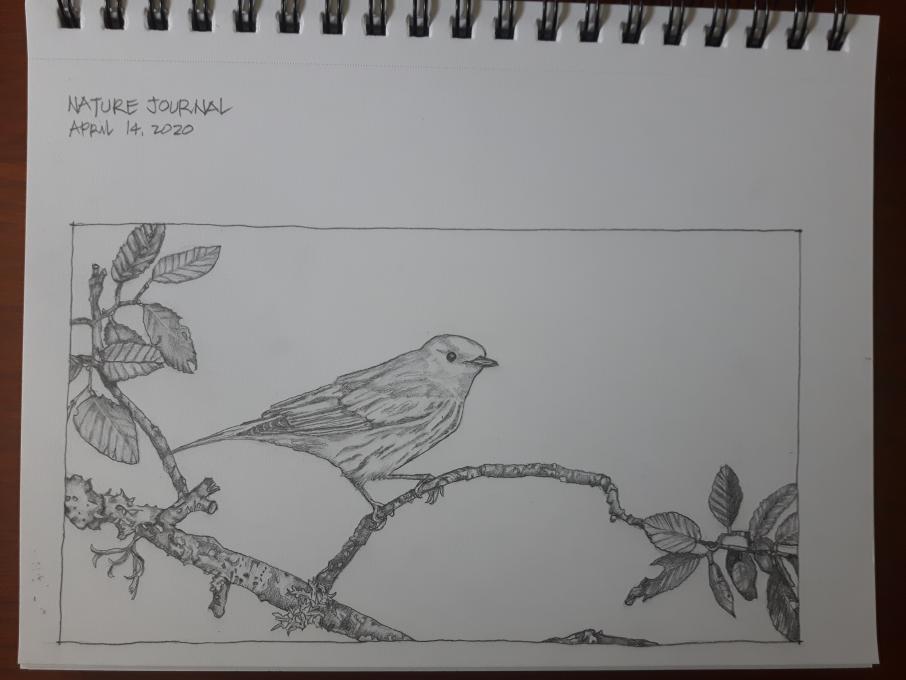


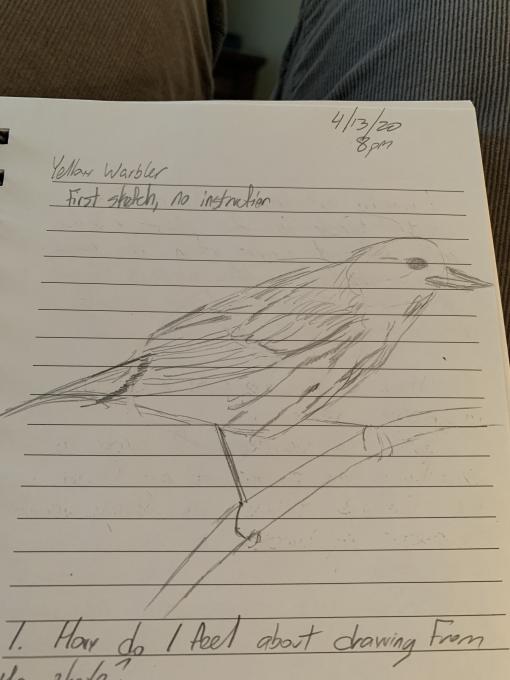

 I normally focus only on the bird itself, so adding the leaves was different and actually I think they are the best thing here.
I tend to try and capture the overall 'feel' rather than details so it's a bit naive in execution, maybe because I'm lazy or impatient.
I didn't quite get the bird right - in the photo he is angled toward the camera and in my picture he's more flat and 2D - capturing depth is something I want to be better at. I think this lacks personality because of that. Also the yellow really isn't right but I have a very limited palette of watercolours.
I did enjoy doing this though. And I love seeing other people's pictures.
I normally focus only on the bird itself, so adding the leaves was different and actually I think they are the best thing here.
I tend to try and capture the overall 'feel' rather than details so it's a bit naive in execution, maybe because I'm lazy or impatient.
I didn't quite get the bird right - in the photo he is angled toward the camera and in my picture he's more flat and 2D - capturing depth is something I want to be better at. I think this lacks personality because of that. Also the yellow really isn't right but I have a very limited palette of watercolours.
I did enjoy doing this though. And I love seeing other people's pictures.  I had to erase and redraw so many times and the proportions are still off. I find I have a hard time maintaining proportions, even when breaking images down into basic shapes.
I had to erase and redraw so many times and the proportions are still off. I find I have a hard time maintaining proportions, even when breaking images down into basic shapes.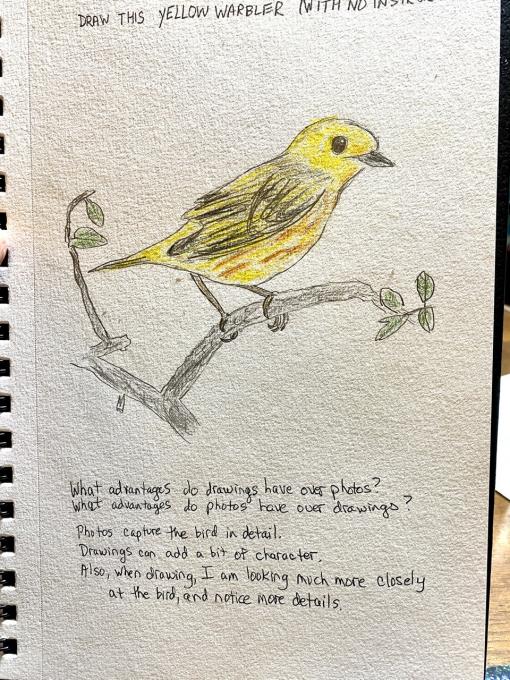
 I tried to use the technique from one of the journalists in the introductory videos that said to look at the hidden circles within the bird to complete this sketch. The difficulty was that I saw way too many circles and then triangles, rectangles, trapezoids and so on! I got lost in the shapes and finally just went with my gut. What was most frustrating was that I kept jumping around the page and then settled on completing the bird last and spent more time with detail. I got overwhelmed with the level of detail that everything required and didn’t want to invest the time required so I budgeted accordingly. I just wanted to get it done! Overall, I am impressed with my first attempt and am looking forward to the skills I’ll learn along the way in this course. I love sketching but feel I am horrific at painting and watercolor. I’m really hoping to learn some helpful tips for that, but am terrified at the thought of attempting them at the same time.
I tried to use the technique from one of the journalists in the introductory videos that said to look at the hidden circles within the bird to complete this sketch. The difficulty was that I saw way too many circles and then triangles, rectangles, trapezoids and so on! I got lost in the shapes and finally just went with my gut. What was most frustrating was that I kept jumping around the page and then settled on completing the bird last and spent more time with detail. I got overwhelmed with the level of detail that everything required and didn’t want to invest the time required so I budgeted accordingly. I just wanted to get it done! Overall, I am impressed with my first attempt and am looking forward to the skills I’ll learn along the way in this course. I love sketching but feel I am horrific at painting and watercolor. I’m really hoping to learn some helpful tips for that, but am terrified at the thought of attempting them at the same time. 